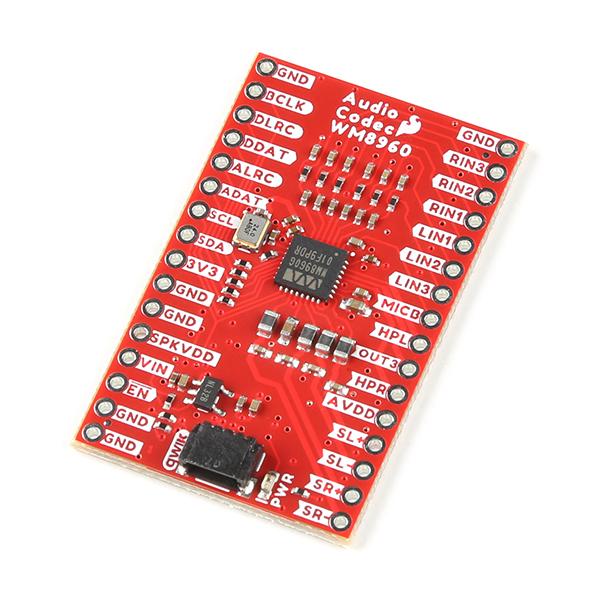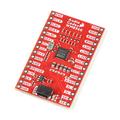SparkFun Audio Codec Breakout - WM8960 (Qwiic)

Description Attachments
The SparkFun WM8960 Audio Codec Breakout is an exceptional stereo codec with 1W Stereo Class D speaker drivers and headphone drivers. It operates as a stereo audio ADC and DAC, communicating via I2S, an industry-standard audio data protocol. This audio codec is packed with advanced features such as on-chip digital signal processing for automatic level control (ALC) for line or microphone input, programmable gain amplifier (PGA), pop and click suppression, and the ability to configure I2S settings and analog audio path through software via I2C.
With 6x flexible analog input pins, the SparkFun WM8960 Audio Codec Breakout can accommodate a variety of sound source signal types, from line level to microphone level (balanced and unbalanced) sources. This makes it possible to accept audio from computer sound cards, smartphone headphone outputs, electret microphones, MEMs microphones and more. The flexible analog signal routing includes PGAs and multiple boost stages to accept a wide range of audio signal levels.
The efficient class-D driver ensures low heat and long battery life when driving 8Ω speakers at up to 1W per channel for portable audio applications. Alternatively, it can drive 16Ω headphones at up to 40mW. The 3D enhancement feature can be used to increase the separation between the left and right channels, creating a fuller, more immersive sound experience.
The SparkFun WM8960 Audio Codec Breakout is easy to connect to a breadboard, with the WM8960 pins broken out along the edge of the PCB with 2.54mm-spaced pins. The Qwiic system allows for simple wiring of the I2C port when configuring the audio codec's settings. A power LED (PWR) is included on the board to indicate when power is applied. The board also includes a built-in XC6222 3.3V/700mA voltage regulator to regulate the voltage for the analog circuit, along with jumpers for users who want to power each with a separate power supply.
The SparkFun WM8960 Audio Codec Breakout is an excellent choice for projects requiring the encoding or decoding of audio signals. It's perfect for use in portable digital players or immersive VR games. The board is part of the SparkFun Qwiic Connect System, an ecosystem of I2C sensors, actuators, shields and cables that make prototyping faster and less prone to error.
The board weighs 4.1g and measures 25.4mm x 40.6mm.
Properties
| Brand | Sparkfun |
| Model | BOB-21250 |
| More info | Audio Codec Breakout - WM8960 Hookup Guide - SparkFun Learn |
| Length | 26 mm |
| Width | 42 mm |
| Height | 5 mm |
| Weight | 10,6 g |
Alternative products
Customer questions
Customer Reviews
- In stock Sparkfun Battery Holder - 1x18650 (wire leads) € 2,45 View product
- In stock Sparkfun Hobby Motor - Gear € 3,30 View product
- In stock SparkFun SOIC to DIP Adapter - 20-Pin € 5,75 View product
- In stock Sparkfun RJ11 6-Pin Connector € 2,65 View product
- In stock SparkFun Nano Power Timer - TPL5110 € 11,95 View product
- In stock SparkFun Load Cell Amplifier - HX711 € 13,85 View product
- In stock Sparkfun Thumb Joystick Knob - Deluxe € 1,90 View product
- In stock SparkFun USB Type A Female Breakout € 6,60 View product
- In stock Sparkfun Needle Set € 3,75 View product
- In stock SparkFun Micro 6DoF IMU Breakout - BMI270 (Qwiic) € 19,75 View product
- In stock Sparkfun Slide Pot - Medium (10k Linear Taper) € 3,05 View product
- In stock Sparkfun Teensy Stackable Header Kit (Extended) € 2,90 View product
- In stock Sparkfun Hall-Effect Sensor - AH1815 (Non-Latching) € 1,90 View product
- In stock Sparkfun Ribbon Cable - 10 wire (3ft) € 1,95 View product
- In stock Sparkfun 14-Segment Alphanumeric Display - Blue € 3,75 View product










